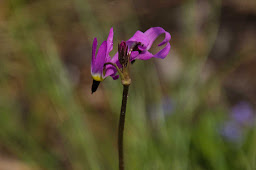 |
| Pretty Shooting Star; Uintas, 7/7/2020, David Kenison |
Shooting Stars are members of the Primulaceae (Primrose) family. There are over a dozen species in the genus Dodecatheon, all native to North America. Several of them grow in Utah and have very similar appearance, including the Alpine Shooting Star (Dodecatheon alpinum), the Bonneville Shooting Star (Dodecatheon conjugens), and the Jeffrey's Shoorting Star (Dodecatheon jefferyi). The genus name Dodecatheon means "twelve gods" in Greek. Other names for the flower include Few-flowered Shooting Star, Dark Throat Shooting Star, Prairie Shooting Stars, American cowslip, Mosquito bills, Mad violets, and Sailor caps.
This attractive small pink, red-violet, or magenta flower is normally found in very moist areas such as springs, seeps, and marshy meadows. Stems grow 12 to 15 inches tall and the blossoms are from a half inch to an inch long. The distinctive red petals with bands of white and yellow lead to the black protruding stamen. The stem bends down to display the unique flower that seems somehow upside down and inside out, with the petals flowing back upwards and the downward-reaching stamen forming a tube. In addition to a shooting star, it's been described as a blazing comet or a mini fireworks display.
The flowers respond in a unique way to bumblebees; as the bees grasp the tube formed by the five sepals, the vibration of their buzzing wings shakes the pollen grains onto the bee's body. After the flower is polinated, the flower rotates up so the shooting star is pointed to the sky.
These photos were taken by the author at a variety of locations around Utah. Click to view enlargements.




No comments :
Post a Comment